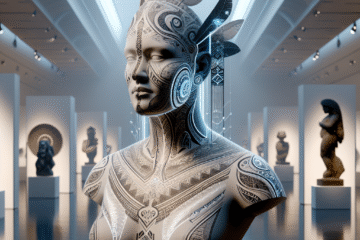
Image title: The Crucifixion; The Last Judgment
Medium: Oil on canvas, transferred from wood
Date: ca. 1436–38
Source:
The Met Collection
“
Be slow to fall into friendship; but when thou art in, continue firm and constant.
”
— Isocrates
When Paintings Listen Back: Interactive Canvases and Sonic Art Integration
Introduction: The Canvas Awakens
In the evolving world of contemporary art, the once passive canvas is coming to life. Paintings no longer exist only to be seen—they can now listen, react, and engage. By integrating sound and responsive technologies into traditional visual art forms, artists are creating immersive, multi-sensory experiences that challenge how we perceive and participate in art. The intersection of sound, viewer interaction, and visual elements signals a bold frontier: one where the artwork is not completed until it’s experienced, felt, and even heard. This article delves into the history and evolution of this avant-garde movement, tracing its roots and exploring how emerging technologies are shaping a new kind of artistic expression.
1. From Silent Aesthetics to Sonic Echoes: A Prelude in Modernism
While the full integration of audio into paintings is a relatively recent breakthrough, many of its philosophical roots can be traced back to early 20th-century art. Kandinsky, a pioneer of abstraction, often referred to musicality in art, seeking to ‘hear’ colors and ‘see’ sounds—a phenomenon known as synesthesia. His work suggested an early yearning for cross-sensory integration long before technology could catch up. Similarly, the Futurists and Dadaists emphasized movement, sound, and audience disruption in their performances and assemblages. These artists laid the conceptual groundwork for what would later become technologically enabled interactive art: the desire for art to transcend its frame and stir all the senses.
2. Cybernetics and Control: The 1960s Tech-Art Experiments
The post-war era, particularly the 1960s, saw a radical shift as computers and cybernetic theories infiltrated the art world. Visionaries like Nam June Paik and John Cage explored the symbiosis between randomness, audience, and technology. Paik’s video installations frequently incorporated sound and feedback loops, while Cage’s theories of ambient sound as music redefined what art could be. The Experiments in Art and Technology (E.A.T.) group, formed in 1967, brought engineers and artists together, paving the way for audiovisual projects where canvases could theoretically respond to stimuli—in light, motion, and sound. Although actual “listening” paintings remained speculative, the concept of reactive artworks began taking tangibly experimental form.
3. The Digital Renaissance: 1990s to Early 2000s
The rise of digital tools in the 1990s democratized access to technology-driven media. Artists began incorporating embedded electronics, sensors, and sound chips into physical installations. Interactive artworks moved into galleries and public spaces, where proximity sensors triggered lights, sound, or movement. Pioneering artists like Camille Utterback and Rafael Lozano-Hemmer began engaging viewers as participants instead of passive observers. Their works merged visual aesthetics with responsive systems, often using real-time data, motion tracking, or audio triggers to activate shifts in the artwork’s presentation—clearly signaling that the era of static observation was over.
4. Listening Paintings: Today’s Sonic-Art Integrations
Contemporary artists are now directly infusing paintings with sonic layers, thanks to touch-sensitive surfaces, microcontroller boards like Arduino, and immersive audio design software. Imagine a painting that emits whispers when someone approaches, or shifts its palette as surrounding sounds intensify. Projects like Lianne Vos’s ‘Resonance’ or Neil Harbisson’s color-to-sound experiments explore the aesthetic and emotional capacities of sound-responsive works. These

Image description:
Megapixel Girl with a Pearl Earring by Johannes Vermeer.
License:
Public domain
Source:
Wikimedia Commons
Useful links:


